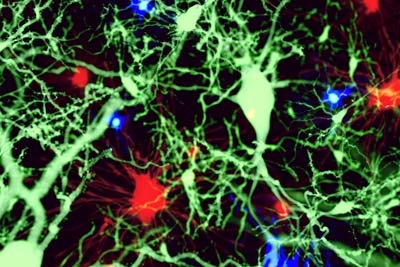Learn about brain health and nootropics to boost brain function
Mouse study shows microglia not just trash disposal, but essential to healthy neuron balance

Microglia, the brain’s cleanup crew, may also play an important role in regulating a healthy balance and function of surrounding neural cells. Microglia are resident immune cells in the brain that patrol the central nervous system’s cellular environments rapidly detecting, surrounding, and disposing of damaged cells, germs, and other cellular debris. One part of microglia’s job is devouring the corpses of dead brain and nervous system cells via a process known as phagocytosis. Microglia (blue) are more than just a cleanup crew. They actually help maintain a healthy life cycle of neurons (green). Mature, functioning neurons in the hippocampus region of the brain continually grow from neural stem cells in the adult brain (a process called neurogenesis), developing over time into established neuronal circuits. In adults, most newborn neurons are programmed to die quickly after they are born and are promptly gobbled up by phagocytosis then carried away by microglia.
While the conventional scientific wisdom held that this microglial cleanup was just a passive trash disposal process, an international team of researchers, in part supported by NIA, found there is more to microglia’s role than meets the microscope-aided eye. They published their findings in the Journal of Neuroscience .
The team zoomed in on how lab mice produce new neurons in the hippocampus, which is vital for learning and memory. Using a type of genetically modified mouse model in which microglial phagocytosis was blocked, they observed a corresponding drop in hippocampal neurogenesis. This was a sign that microglia and recently born neurons had some sort of communications connection.
Next, the team fed apoptotic cells to microglia grown in the lab so they could more closely monitor the process. They saw that phagocytosis was actually a highly energetic business, sparking genetic and metabolic changes in the microglia. The microglia’s secretome — the collection of signature proteins that the cells released — seemed to be the mechanism for signaling newborn neurons. The data suggested that through this process, microglia sense cell death rates, and help boost or brake neuron production, thus orchestrating the neuronal birth and death cycle to maintain a healthy balance.
Like microbes, worms, and insects that break down the flesh of dead animals to enrich soil for new growth, microglia are an essential and more complex part of the nervous system’s circle of birth, life, and death than previously realized. The researchers hope this better understanding of the communication circuits behind natural cycles of neuronal death may help target microglial phagocytosis as a route to potential future strategies or therapies for age related and neurodegenerative diseases.
This work was supported in part by NIA grant AG060748.
Reference : Diaz-Aparicio I, et al. Microglia actively remodel adult hippocampal neurogenesis through the phagocytosis secretome . Journal of Neuroscience . 2020;40(7):1453-1482. doi: 10.1523/JNEUROSCI.0993-19.2019.